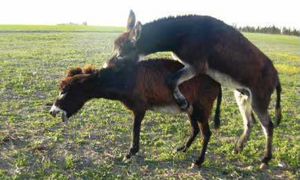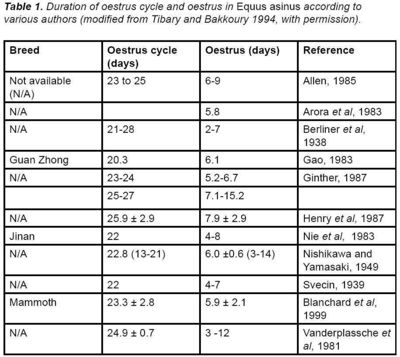Oestrus Cycle - Donkey


The oestrous cycle is slightly longer than that of the mare and normally lasts 23 to 24 days, but can range from 13 to 31 days (Table 1). Oestrus lasts 3 to 15 days. Signs of oestrus include tail raising, urination stance, winking of the clitoris, ears back, mounting other females, standing to be mounted and vulvar oedema. These signs intensify in the presence of the male and are accompanied by a yawning reflex with the neck extended (jaws clamping, yawning) (Henry et al, 1987; Fielding, 1988; Tibary and Bakkoury, 1994).
Follicular dominance is established at a diameter of about 25 mm. Most dominant follicles are about 27 mm in diameter at the onset of oestrus. Follicular growth averages 2.7 mm per day (Dadarwal et al, 2004). Ovulation takes place during the last 24 hours of heat.
Behavioural oestrus persists a few hours (0.7-0.8 days) after ovulation (Vandeplassche et al, 1981, Henry et al, 1987). The average size of the preovulatory follicle may be breed-dependent. It is 30 to 33 mm in the Poitou and 35 to 40 (39.4 mm) in the Pega and Mammoth (Lun et al, 1998). North African jennies may ovulate at a smaller size (32 mm).
An incidence of double, triple and quadruple ovulations of respectively 25.5%, 10.5% and 1.1% has been reported in some breeds. The incidence of multiple ovulations generally ranges from 5 to 32 % (Vandeplassche et al, 1981; Ginther et al, 1987; Meira et al, 1995; Blanchard and Taylor, 2005). Double ovulation incidence can be as high as 37%. Incidence of multiple ovulations can reach 61% in mammoth jennies (Blanchard et al, 1999). The majority (75%) of double ovulations are asynchronous with the interval between ovulations ranging from one to four days in general and up to eleven days in some instances. The incidence of double ovulations and twinning is extremely low in the North African donkey.
In general, jennies are in oestrus until occurrence of the second ovulation (Vandeplassche et al, 1981). Twin births are rare, but have been reported in higher numbers in the Mammoth jenny and in the dairy breed Ragusana in Sicily (Mancuso et al, 2004). The approach to twin management should be similar to that used in mares.
The inter-ovulatory period is significantly longer in jennies than in mares (Vandeplassche et al, 1981; Ginther et al, 1987; Meira et al, 1995). The average life span of the corpus luteum is 15 to 20 days (19.3 ±0.6 in standard jennies (Vandeplassche et al, 1981) and 17.4 ± 2.6 days in mammoth jennies (Blanchard et al, 1999). The inter-ovulatory period is 24.9 ± 0.7 days for standard and 23.3 ± 2.6 days for mammoth jennies (Vandeplassche et al, 1981; Blanchard et al, 1999).
The ultrasonographic characteristics of the uterus at different phases of the oestrus cycle are similar to those described for the mare (Lemma et al, 2006).
Literature Search
Use these links to find recent scientific publications via CAB Abstracts (log in required unless accessing from a subscribing organisation).
Donkey Oestrus Cycle publications
References
- Tibary, A., Sghiri, A. & Bakkoury, M. (2008) Reproduction In Svendsen, E.D., Duncan, J. and Hadrill, D. (2008) The Professional Handbook of the Donkey, 4th edition, Whittet Books, Chapter 17
- Blanchard, T.L., Taylor, T.S., and Love, C.L. (1999). ‘Estrous cycle characteristics and response to estrus synchronization in mammoth asses (Equus asinus americanus)’. Theriogenology 52. pp 827-834.
- Dadarwal, D., Tandon, S.N., Purohit, G.N., and Pareek, P.K. (2004). ‘Ultrasonographic evaluation of uterine involution and post-partum follicular dynamics of French Jennies (Equus asinus)’. Theriogenology 62. pp 257-264.
- Fielding, D. (1988). ‘Reproductive characteristics of the jenny donkey - Equus asinus: a review’. Tropical Animal Health and Production 20. pp 161-166.
- Ginther, O.J., Scrabam, S.T., and Bergfelt, D.R. (1987). ‘Reproductive seasonality of the jenny’. Theriogenology 27. pp 587-592.
- Henry, M., Figueiredo, A.E.F., Palhares, M.S., and Coryn, M. (1987). ‘Clinical and endocrine aspects of the estrous cycle in donkeys (Equus asinus)’. Journal of Reproduction and Fertility Suppl.35. pp 297-303.
- Lemma, A., Bekana, M., Schwartz, H.J., and Hildebrant, T. (2006). ‘Ultrasonographic study of ovarian activities in the tropical jenny during the seasons of high and low sexual activity’. Journal of Equine Veterinary Science 26. pp 18-22.
- Lemma, A., Bekana, M. , Schwartz, H.J., and Hildebrant, T. (2006) ‘The effect of body condition on ovarian activity of free ranging tropical jennies (Equus asinus)’. Journal of Veterinary Medicine Series A- Physiology and Pathology Clinical Medicine 53. pp 1-4.
- Lun, S., He, C., Zhang, Y., Chen, Z., Hu, W., Lu, S., Jia, W., and Zhang, Q. (1998). ‘Preliminary study on development of follicles and formation of corpus luteum of the jenny and mare by ultrasonography’. Acta Veterinaria et Zootechnica Sinica 29. pp 419-425.
- Meira, C.,Ferreira, J.C.P., Papa, F.O., and Henry, M. (1995). ‘Study of the estrous cycle in donkeys (Equus asinus) using ultrasonography and plasma progesterone concentrations’. Biol Reprod Monograph 1. pp 403-410.
- Tibary, A., Bakkoury, M.(eds). (1994). ‘Particularités de la reproduction chez les autres espèces équines’. Reproduction équine, Tome I: La jument. Actes Editions 1994. pp 385-400.
- Vandeplassche, G.M., Wesson, J.A., and Ginther, O.J. (1981). ‘Behavioral, follicular and gonadotropin changes during estrous cycle in donkeys’. Theriogenology 16. pp 239-249.
|
|
This page was sponsored and content provided by THE DONKEY SANCTUARY |
|---|
